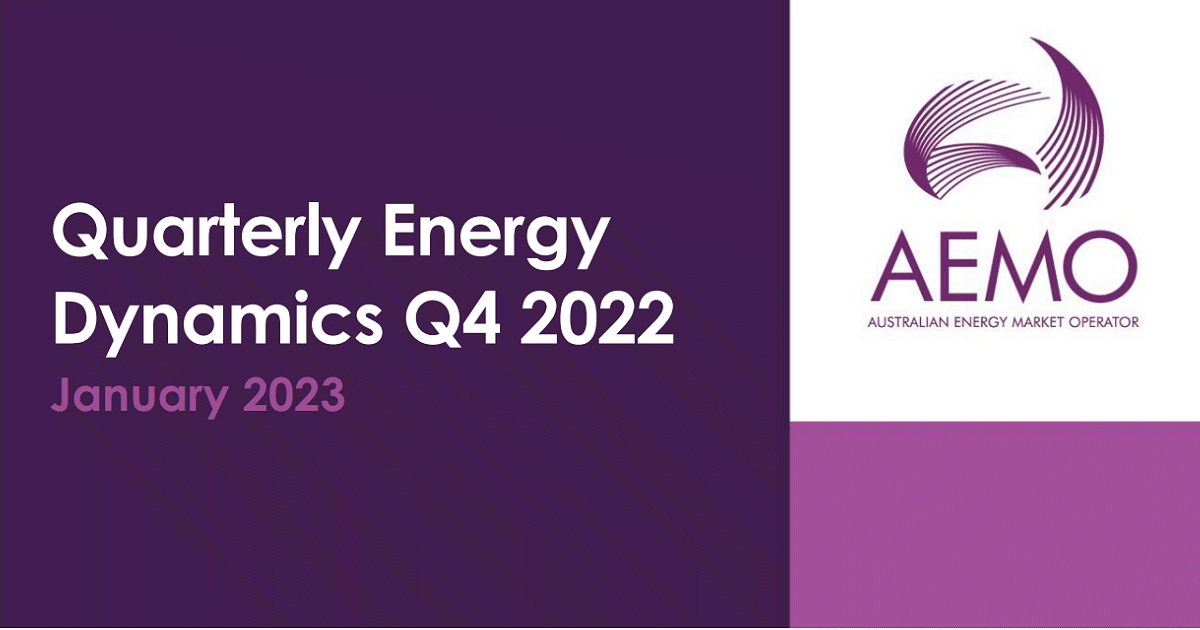The good news is wholesale electricity prices in Australia’s National Electricity Market (NEM) dropped a long way during the December quarter. The bad news is prices were still well above a year prior.
The Australian Energy Market Operator’s (AEMO’s) latest Quarterly Energy Dynamics (QED) report indicates wholesale prices averaged $93 per megawatt hour (MWh) across the NEM during the December 2022 quarter, down 57% from the September quarter ($216/MWh). However, they were still a long way off Q4 2021’s average of $52/MWh.
“Following the Federal Government’s temporary capping of wholesale domestic gas and thermal coal markets on 9 December, ASX Cal23 electricity futures prices saw steep falls in the mainland states through to the end of the quarter,” said AEMO’s Violette Mouchaileh.
A few days prior to the release of the AEMO’s report, the Albanese Government said reductions in wholesale electricity prices resulting from its Energy Price Relief Plan actions will take some time to flow through to households, but they should expect to pay $230 less in 2023-24.
But it’s important to note the Energy Price Relief Plan isn’t expected to bring down what were already increased electricity prices from where they were in December last year, just to reduce the amount they would otherwise further increase by. It’s another good reason for households (and businesses) to install solar sooner rather than later.
Renewable Energy Shines In Q4
And speaking of solar energy, some other good news was output from wind and utility-scale solar power produced 20% of total generation in the NEM during the last quarter as new facilities were connected and commissioned.
Along with lower demand due to milder conditions and the lowest output from coal-fired power generation since the NEM commenced back in 1998, NEM emissions dropped to the lowest quarter on record at 26.4 million tonnes carbon dioxide equivalent (CO2e) – 5.6% lower than Q4 2021 levels. Western Australian Wholesale Electricity Market (WEM) emissions dropped 11%.
The quarter certainly wasn’t without incident. The AEMO notes high price volatility was the result of a transmission failure in South Australia, following a storm event that saw a bunch of blackouts in the state and SA disconnected from the rest of the NEM for a week.
“While SA lost interconnection, instantaneous renewable penetration in SA peaked at an extraordinary 91.5% on 19 November,” said Ms. Mouchaileh.
SQ’s Anthony recently took a deep dive into how SA’s electricity system managed during the event until reconnected, and the impacts on small-scale solar power – it’s well worth a read.
Ms. Mouchaileh said the November event in SA was a glimpse of the future, “when both batteries and gas generation will be key to Australia realising its renewable potential.”
During the quarter, new instantaneous renewable penetration records were also set in the NEM at 68.7% on 28 October and in the WEM at 84.3% on 12 December. These events were largely driven by high levels of distributed solar power states the AEMO.
The AEMO’s full Quarterly Energy Dynamics – Q4 2022 covering 1 October to 31 December 2022 can be viewed here.


 RSS - Posts
RSS - Posts



Just had solar system installed (15 days sooner than estimated time) by an extremely friendly and professional Sunterra team. I would highly recommend this company to anyone
“… expect to pay $230 less in 2023-24”? Yeah right. I’ll believe that if ever I see it!!!
As this piece notes, the savings aren’t actual savings, but rather theoretical savings versus how much more you might have paid had Labor not waved their magic wand. And note the ABC article linked to states the average Australian electricity bill WILL RISE $700 by the middle of next year.
So bills are going up, the only question is how high.
Yes, that is a strange statement. Unless they have plans I am unaware of, homes in the NEM can expect to pay a lot more for grid electricity next financial year. Especially in QLD.
Batteries are getting closer to viable at this rate. Mind you with the cost of lithium too …… seems to be lose-lose.
It’s possible we won’t see a decline in battery prices this year but we should next year thanks to increasing lithium supply.
Michael,
Congratulation on a succinct but honest title to the article, by including the “BUT….”
Dan Lees article in WattClarity summaries the title from other organizations.
They focus on the 56% fall in price from Q3 to Q4.
No hint of the 53% increase from Q4 2021, a more sensible comparison.
Does it make sense to compare Q3 to Q4? You would compare temperature, wind or radiation between quarters.
Q4 changes in cost per MWh were $108 in 2022, $70 in 2021, $75 in 2019 (pre-Covid) and $21 in 2010! (Extracted from OpenNEM)